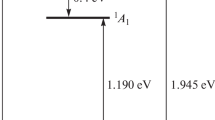Abstract
The rate of the multiphonon relaxation of the 1s(T2) level in Se+ donors in silicon is estimated. The calculation comprises the initial approach to the problem, in which the most simplified form of wave functions is used. To evaluate the transition probability, the Pässler expression known from publications is used [R. Pässler, Czech. J. Phys. B 24, 322 (1974)]. This expression was derived in terms of the so-called static approximation. The deformation potentials of optical and acoustic phonons were determined by the fitting procedure using published data on the luminescence spectrum of Se+ donors at the 1s(T2)–1s(A1) transition and Franck–Condon principle. Evaluation for the relaxation rate of 103 s–1 turned out to be five orders of magnitude smaller than the rate corresponding to the experimentally measured lifetime. The cause of disagreement with the experiment is the excessively simplified model, which does not taking into account several factors, the main one being the presence of quasi-local oscillatory modes. Analysis of the luminescence spectrum based on the mentioned transition leads to the conclusion that the energies of such oscillatory modes lie in the range from 26 to 61 meV. To attain satisfactory agreement with the experiment, the model should be made more complex taking into account the interaction with these modes.

Similar content being viewed by others
Notes
The data of article [3], including their processed form, are admitted to the repeated publication under the conditions of the International License “Creative Commons Attribution 4.0” with reference to the source.
REFERENCES
H. G. Grimmeiss, E. Janzen, and K. Larsson, Phys. Rev. B 25, 2627 (1982).
K. J. Morse, R. J. S. Abraham, A. DeAbreu, C. Bowness, T. S. Richards, H. Riemann, N. V. Abrosimov, P. Becker, H.-J. Pohl, M. L. W. Thewalt, and S. Simmons, Sci. Adv. 3, e1700930 (2017).
A. DeAbreu, C. Bowness, R. J. S. Abraham, A. Medvedova, K. J. Morse, H. Riemann, N. V. Abrosimov, P. Becker, H.-J. Pohl, M. L. W. Thewalt, and S. Simmons, Phys. Rev. Appl. 11, 044036 (2019).
M. Lax, J. Chem. Phys. 20, 1752 (1952).
R. Pässler, Czech. J. Phys. B 24, 322 (1974).
R. Pässler, Czech. J. Phys. B 25, 219 (1974).
Huang Kun, Sci. Sin. 24, 27 (1981).
E. Gutsche, Phys. Status Solidi B 109, 583 (1982).
N. A. Bekin, Semiconductors 53, 1340 (2019).
M. Born and K. Huang, Dynamical Theory of Crystal Lattices (Clarendon, Oxford, 1954).
R. Kubo and Y. Toyozawa, Progr. Theor. Phys. 13, 160 (1955).
B. K. Ridley, Solid State Electron. 21, 1319 (1978).
P. Giannozzi, S. de Gironcoli, P. Pavone, and S. Baroni, Phys. Rev. B 43, 7231 (1991).
A. Dargys and J. Kundrotas, Handbook on Physical Properties of Ge,Si, GaAs and InP (Vilnius, 1994).
K. K. Rebane, Impurity Spectra of Solids: Elementary Theory of Vibrational Structure (Plenum, New York, London, 1970; Nauka, Moscow, 1968).
E. Janzén, G. Grossmann, R. Stedman, and H. G. Grimmeiss, Phys. Rev. B 31, 8000 (1985).
Funding
This study was supported by the joint Russian–German RFBR-DFG project (DFG project no. 389056032 and RFBR project no. 18-502-12077-DFG).
Author information
Authors and Affiliations
Corresponding author
Ethics declarations
The author declares that he has no conflict of interest.
Additional information
Translated by N. Korovin
Rights and permissions
About this article
Cite this article
Bekin, N.A. Multiphonon Relaxation of the 1s(T2) States of a Singly Ionized Selenium Donor in Silicon. Semiconductors 54, 1112–1118 (2020). https://doi.org/10.1134/S1063782620090043
Received:
Revised:
Accepted:
Published:
Issue Date:
DOI: https://doi.org/10.1134/S1063782620090043




